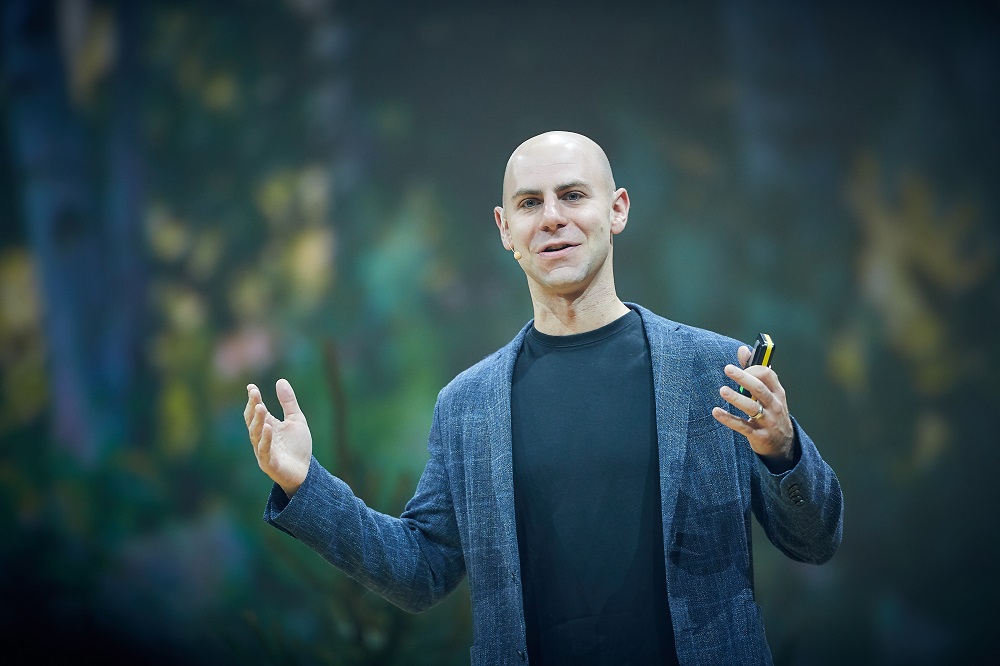For today’s modern business leaders, innovation is key to success.
“We live in a rapidly changing world with more uncertainty than ever before. This means we need to be better and faster at rethinking our assumptions.”
Innovating in a continuously developing tech environment requires leaders to challenge the status quo, rethink their assumptions, and be open to learning new skills. In this article, world-renowned organizational psychologist and best-selling author Adam Grant shares practical and actionable strategies to help leaders unlock the hidden potential in themselves and the people around them.
1. BUILD A CHALLENGE NETWORK
Although a support network filled with mentors and sponsors is valuable, Grant introduces another kind of network that is critical for success.
“Your challenge network is the group of thoughtful critics who you trust to hold up a mirror so you can see your own blind spots more clearly. They’re the people who have the courage to tell you the unpleasant truths.”
However, Grant observes that many leaders around the world don’t have a challenge network. “That is a scary world to live in. So how do you get people to challenge your assumptions?” He shares a dynamic he’s been studying his whole career, the act of observing your network and identifying the givers and takers.
GIVERS: “People who are constantly figuring out what they can do for you.”
TAKERS: “People who want to know what you will do for them.”
There is also the personality trait of agreeableness. “Agreeable people are warm, friendly, polite, and welcoming. Disagreeable people are more critical, skeptical, and challenging. For a long time, I assumed that agreeable people were always givers.”
Grant then gathered data from 30,000 people around the world from different cultures and industries. The findings were surprising. “I found a zero correlation between how far you lean toward giving versus taking at work, and where you stood on that spectrum from agreeable to disagreeable personality.” He realized that the level of agreeableness was only a surface-level trait. On the other hand, giving and taking present an individual’s inner motives. “What are your real values and intentions when you deal with others?”
To understand people more accurately, Grant categorizes people in the table below. “This is an oversimplification of all the complexity of human nature. But when you do this, you will find two combinations you recognize quickly, and maybe two that you overlook.”

Ultimately, disagreeable givers are assets in a challenge network. “We need to do a much better job of valuing these people, as opposed to writing them off as prickly and a selfish taker.” Grant encourages business leaders to reach out to the disagreeable givers they know as a first step to building their challenge network. He has reached out to disagreeable givers in his network too. “As I’ve had those conversations, I’ve gotten much better, not only in constructive criticism but also coaching.”
“I see honesty as the highest expression of loyalty. The more candid you are with me, the more I will know that you’re trying to help me grow.”
2. CREATE PSYCHOLOGICAL SAFETY
Coined by Amy Edmonson, psychological safety is the sense that you can take a risk and speak up without being punished or fearing reprisal. People with psychological safety can freely admit their errors, study what caused them, and rethink routines to prevent them.
“When organizations build psychological safety, people are not only more willing to think again, they’re also more courageous in telling you what you need to rethink.”
Grant adds that in tech companies when people lack psychological safety, they bite their tongues. But when they have it, they let their ideas fly. “I see leaders do this by accident constantly, and they don’t even realize they’re doing it. One of the ways I catch it is when I hear leaders say, ‘Don’t bring me problems, bring me solutions.’ I get why leaders say it. You want people to take initiative and not whine and complain.”
However, Grant says that this is a dangerous philosophy. If people only speak up when they have a solution, leaders will never hear their biggest problems which are too complex for any one person to solve.
“The foundation of building psychological safety is encouraging people to raise problems, even if they don’t know how to fix them yet.”
How can business leaders build psychological safety? “It’s really helpful to create a structure where people are rewarded for telling you what the problems are.”
He gives an example of a Kill the Company exercise given by a consultant. “She divides the leadership team into small groups, and she says, ‘Your job is to put your own company out of business’. I’ve never seen a more energized group of executives in my life. The power of this exercise is people are more creative on offense. Psychological safety is built in when your job is to tell people how you would destroy your company. There is no problem that is unsafe to voice. So, I like to see leaders run this exercise twice a year because inevitably, the threats and opportunities will change.”
Grant refers to these exercises as premortem exercises “where you imagine that one of your big decisions or your key strategies is going to fail in the next few years. And then you consider the most likely reasons why.”
“You get better at seeing around corners, rethinking assumptions that are no longer true, and then evolving to improve your practices. We need to bake this into our interactions with people on a daily basis.”
In addition, he advises business leaders to be more open to admitting their mistakes. It’s not enough for leaders to ask their team for criticism because they don’t know whether their leaders can handle the truth. “It’s often more effective for leaders to say, ‘Here are my mistakes.’ When leaders put their own weaknesses and imperfections on the table, their team has more psychological safety to speak up.
In addition to claiming to want to hear criticism, leaders are proving that they can take it. “A simple way of doing this is to take your own review from your board or from your boss and share it with your team. I’ve seen a lot of leaders hesitate to do this; they don’t want to be too vulnerable. They’re trying to prove their competence.”
“The people around you already know what you’re bad at. You can’t hide it from them. So, you might as well get credit for having the self-awareness to see it, and the humility and integrity to admit it out loud.”
3. GET THE BEST IDEAS ON THE TABLE
Grant also challenges the age-old practice of brainstorming. “There’s a strong tendency when we need creative ideas or make a critical decision to say, ‘Hey, let’s bring a group of people together to brainstorm because we know that five heads are better than two.’ Except for just one tiny wrinkle. It doesn’t work.”
He explains that there is over 40 years of evidence that better ideas are generated if people work alone. In addition, he highlights three things that can go wrong in brainstorming groups:
- Production blocking: “We can’t all talk at once and some ideas get lost.”
- Ego threat: “I don’t want to look stupid, so I hold back on my most unconventional ideas.”
- Conformity pressure: “I want to jump on the bandwagon of the idea that the boss likes best or what’s most popular in the room.”
To avoid the above from happening, Grant presents the idea-generating tactic of brainwriting.
“You give people the problem or the topic and advance. You let them generate their own ideas independently. You collect them and then you have everyone in the group rate them. Once you have everybody’s independent ideas and judgment, you bring everyone together to figure out which possibilities are worth pursuing.”
Why is brainwriting better than brainstorming?
- Individuals are more creative than groups but “they’re also terrible at judging their own ideas.”
- There is more variety of ideas that can be “adjusted and filtered by group wisdom, the wisdom of crowds should come in after we get all the possibilities on the table.”
- It works in a hybrid setting “where the chat window is made for brainwriting. The first 10 minutes is to type out your thoughts and then use the group’s judgment to assess and vet the potential in the room.”
- Provides a platform for the quieter voices “who might not be that comfortable selling and pitching their ideas but are the ones who have actually dreamed up the best ideas.”
“[While] group brainstorming tends to record the loudest talker and the most extroverted person, brainwriting allows you to hear from the deepest thinker and the most creative voices.”
4. RETHINK YOUR MINDSET
After leaders have collected everybody’s independent ideas in a brainwriting process, how do they figure out which ideas work? Grant says it boils down to the mindset they bring to the table. “I’ve been studying the mental models that cause leaders to resist change, refuse to think again, and stymie the hidden potential in their organizations.”
Those mental models can be organized into:
- Preacher: “You’re proselytizing your own views.”
- Prosecutor: “You’re attacking somebody else’s views.”
- Politician: “You don’t bother to listen to people unless they already agree with your views.
“I think it’s worth reflecting on which is your biggest vice of these three mental models. I’ll tell you that mine is prosecutor mode. If I think you’re wrong, I believe it’s my professional and moral responsibility to correct you. I know that when I go into prosecutor mode, I shut down and become less open to new ideas.”
“Whether you’re preaching, prosecuting, or politicking, you’ve already concluded that you’re right and other people are wrong. That means you stop learning.”
How can business leaders release themselves from those mental models? Grant suggests leaders approach new ideas like a scientist and not let ideas become a part of their identity. “We know that good scientists have the humility to know what they don’t know, and the curiosity to constantly seek new knowledge.”
“We have a growing body of evidence that if you teach leaders to think more like scientists, they make better decisions.”
Grant recalls his favorite demonstration of this approach in an experiment done with start-up founders in Italy. Hundreds of entrepreneurs were randomly assigned to a control group or a scientific thinking group. In the scientific thinking group, participants were asked to view their hypotheses as strategies and decisions as experiments. “Over the next year, the founders who have been randomly assigned to think like scientists brought on average more than 40 times the revenue of the control group.”
As for the participants in the control group, Grant says, “When their product launch bombs, they still preach they were right. They prosecute their critics for being wrong, and they politic by lobbying the board to support the status quo.”
“Learning to think like a scientist frees leaders from those traps. They start to listen to the ideas that make them think hard instead of just the opinions that make them feel good. They surround themselves with disagreeable givers who challenge their thought processes.”




